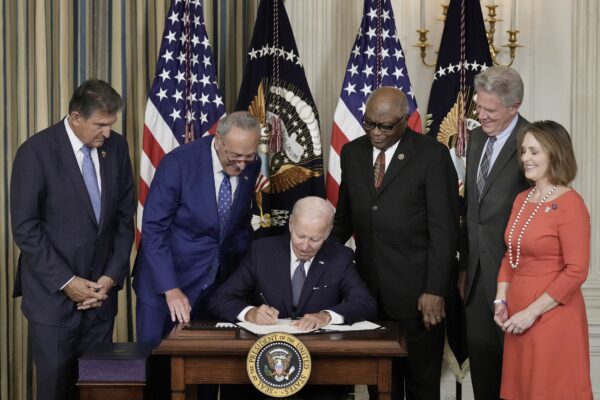


The U.S. Department of Energy (DOE) maintains scaling its $52 billion Fiscal Year 2024 (FY24) budget request back to FY22 funding levels, as House Republicans are proposing, would raise costs for consumers, taxpayers, and industry while derailing momentum in “re-shoring” domestic manufacturing capacity.
“That would be absolutely catastrophic at this critical moment,” DOE Deputy Secretary David Turk told the Senate Appropriations Committee’s Energy & Water Development Subcommittee during a May 3 budget hearing.
According to DOE, “green energy” incentives offered in 2021’s Bipartisan Infrastructure Law (BIL) and 2022’s Inflation Reduction Act (IRA) are generating increasing investor interest in emerging technologies and revisioned industries, including manufacturing.
Noting the IRA was only signed into law last August, Sen. Martin Heinrich (D-N.M.) said the bill helped induce “a record year” in U.S. manufacturing development in 2022 with $150 billion in investments to build 46 factories that will employ more than 18,000 workers.
“We are seeing momentum for re-shoring and we expect to see even more” in 2023 and beyond, Turk agreed, noting much of the proposed 12-percent funding increase in DOE’s FY24 budget request either implements or sustains initiatives funded in the BIL, IRA, and CHIPS & Science Act.
Repeating much of the testimony he provided in Feb. 2 and Feb. 23 appearances before Congressional committees, Turk told the Senate Appropriations sub-panel that BIL allocates $62 billion for DOE to “stand up” 60 new programs and provides expanded funding for 12 additional research projects.
The law created a new Under Secretary for Infrastructure position and four offices—the Grid Deployment Office, the Office of Manufacturing and Energy Supply Chains, the Office of State and Community Energy Programs, and the Office of Clean Energy Demonstrations.
None of the offices will operate if FY22 funding levels are imposed, which will delay or cancel implementation of DOE initiatives under the BIL, IRA, and CHIPS bills, Turk said.
“We have momentum. Why would you want to cut back at the moment when we’re actually succeeding?” he asked.
The BIL, IRA, and DOE’s FY24 budget request are all geared to support “cheap, clean, and abundant energy” to drive the economy while incentivizing domestic energy sourcing, generation, and transmission, said chair Sen. Patty Murray (D-Wash.).
‘“DOE’s budget has tremendous implications for our national security and global competitiveness,” Murray said. “We have to lock arms and work together to make sure our funding keeps pace” with competitors, such as China.
She asked Turk to cite specific examples of what impacts reverting to FY22 level funding would have on Americans and the nation’s economy.
Among immediate casualties, he said, is the $62 million weatherization’ program “that is incredibly popular.” More than 12,000 American businesses and corporations would not receive energy-saver rebates approved by Congress in 2022 and consumers would pay $1 billion a year more in energy bills, he said.
On the “science side,” Turk said there would be “a significant reduction in research and development.”
The DOE would need to ”lay off 5,200 scientists and others who work at our labs,” he said, and trim about 2,600 lab spaces for the department’s commercial and university research “partners” who will find somewhere else to do their work.
This would undermine “all the science we plan to do, want to do, need to do to be competitive” in the 21st century, Turk said. “China competition? We have less ability to deal with that.”
Imposing FY22 funding levels would repeal or retard “all those historical provisions” in the BIL and IRA “at this critical, critical moment, as we are gaining momentum—$150 billion in manufacturing investment—all of that is pulled back at this critical moment, as we’re actually making progress,” which would dramatically impair the “competitive side” of the equation, he said.
Sen. John F. Kennedy (R-La.) said he supports green energy but is leery of the massive investment being committed to quickly transitioning away from fossil fuels to renewable non-carbon energies before anyone knows what will work at the lowest cost and highest environmental benefit.
“I support green energy,” he said. “I think it is going to have to learn how to stand on its own two feet, but I support it.”
Turk had figures ready when asked how reverting to FY22 funding would affect DOE’s FY24 budget plans and impact BIL and IRA program implementations, but he wouldn’t provide specifics when Kennedy asked how much it would cost for the nation to be carbon-neutral by 2050.
“It is going to cost trillions of dollars, and cost tens of trillions of dollars if we don’t,” Turk said, adding it is “a large amount” because the nation would be “fundamentally transforming our energy infrastructure.”
“So you’re advocating we become carbon neutral but you don’t know how much it is going to cost?” Kennedy asked.
Turk said he’s seen ‘a lot of estimates out there” about costs but can say “with a certainty, that it is cheaper to get our act together on climate change than it is to not get our act together.”
Kennedy persisted: “You want us to ‘get there’ but you cannot tell the American taxpayer the cost? Is that your testimony?”
“It is going to save us money and … a lot of jobs,” Turk said.
Kennedy had figures in mind. “How about $50 trillion. Is that right? Some of your colleagues estimate $53 trillion. I’m concerned [Turk wouldn’t cite estimates]. It indicates you don’t care how much it costs.”
He asked Turk how that estimated $53 trillion effort by the United States to reduce carbon emissions will lower the planet’s temperatures or, at least, keep temperatures from rising, and thus stymie the existential advance of climate change.
Turk would not offer a specific estimate or even a guarantee that it would have any benefit beyond reducing the 13.6 percent of global carbon emissions emitted from the United States.
“Unless the U.S. gets its act together on climate change,” it’s not going to happen, he said. “The U.S. needs to lead.”
But first it needs to know where it’s going, said Kennedy.
“We’re going to spend $53 trillion and you don’t know how much it is going to lower temperatures,” he said.
“Now, I’m all for carbon neutrality, but … you are advocating that we spend trillions of dollars to get to carbon neutrality and you can’t tell me, or won’t tell me, how much that is going to lower world temperatures.”


